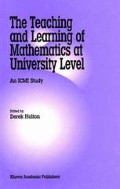Conclusions
The number of new concepts in analysis, coupled with the new standards of rigour in university mathematics, makes the learning ofanalysis difficult. No course aiming to cover the standard amount of work in the standard amount of time could hope to change this. However, the intuitive ideas of the mathematicians who developed and taught on this course have led to a new pedagogy: small classes, collaborative learning, questions that encourage students to develop the mathematical content and arguments for themselves. The new course provides for negotiation of a new didactic contract, fast feedback from fellow students and from experienced and sensitive staff and the answering of questions which emphasise the manipulation of definitions. Through this it encourages students to amend their evolutionarily developed general cognitive strategy, which is such a powerful way of thinking outside formal mathematics, with a new awareness vital to understanding university mathematics: therigourprefix.
Access this chapter
Tax calculation will be finalised at checkout
Purchases are for personal use only
Preview
Unable to display preview. Download preview PDF.
References
Alcock, L. and Simpson, A. (1998). Definitions in university students’ perceptions of structure. International Conference on the Teaching of Mathematics, Samos: University of the Aegean, 19–21.
Alcock, L.J. and Simpson, A.P. (1999). The rigour prefix. In O. Zaslavsky (Ed.), Proceedings of the 23 rd International conference for the Psychology of Mathematics Education, Vol 2, 17–24.
Barkow, J., Cosmides, L. and Tooby, J. (1992). The Adapted Mind: Evolutionary Psychology and the Generation of Culture. Oxford: Oxford University Press.
Brousseau, G. and Otte, M. (1991). The fragility of knowledge. In A.J. Bishop, S. Mellin-Olsen and J. van Dormolen (Eds.), Mathematical Knowledge: Its Growth Through Teaching, pp. 13–36. Dordrecht: Kluwer Academic Publishers.
Burn, R.P. (1992). Numbers and Functions: Steps into Analysis, Cambridge: Cambridge University Press.
Chazan, D. (1993). High school geometry students’ justification for their views of empirical evidence and mathematical proof. Educational Studies in Mathematics, 24, 359–387.
Cooper, B. (1990). PGCE students and investigational approaches to secondary mathematics. Research Papers in Education, 5(2), 127–151.
Davis, R.B. and Vinner, S. (1986). The notion of limit: Some seemingly unavoidable misconception stages. Journal of Mathematical Behaviour, 5(3), 281–303.
Dearing, R. (1997). Higher Education in the Learning Society: Report of the National Committee of Inquiry in Higher Education. London: HMSO.
Dreyfus, T. (1991). Advanced mathematical thinking processes. In D. Tall (Ed.), Advanced Mathematical Thinking, pp. 25–41. Dordrecht: Kluwer Academic Publishers.
Dubinsky, E., Elterman, F. and Gong, C., (1988). The student’s construction of quantification. For the Learning of Mathematics, 8(2), 44–51.
Evans, L. and Abbott, I. (1998). Teaching and Learning in Higher Education. London: Cassell.
Fodor, J.A., Garret, M.F., Walker, E.C. and Parley, C.H. (1980). Against Definition. Cognition, 8, 263–267.
Freyd, J.J. (1983). Shareability: the social psychology of epistemology. Cognitive Science, 7, 191–210.
Gray, E., Pinto, M., Pitta, D. and Tall, D. (1999). Knowledge Construction and diverging thinking in elementary and advanced Mathematics. Educational Studies in Mathematics, 38(1–3), 111–133.
Halmos, P. (1960). Naïve Set Theory. London: Van Nostrand.
Hanna, G. and Jahnke, H.N. (1993). Proof and application. Educational Studies in Mathematics, 24(4), 421–438.
Harel, G. and Tall, D.O. (1991). The general, the abstract and the generic in advanced mathematical thinking. For the Learning of Mathematics, 11(1), 38–42.
Johnson-Laird, P.N. and Byrne, R.M.J. (1991). Deduction, Hillsdale. Lawrence Erlbaum Associates.
Lakoff, G. (1987). Women, fire and dangerous things—what categories reveal about the mind. Chicago: University of Chicago Press.
LMS (1995). Tackling the Mathematics Problem. London: London Mathematical Society.
Markman, E. (1989). Categorization and Naming in Children: Problems of Induction. Cambridge, Mass: MIT Press.
Moore, R.C. (1994). Making the transition to formal proof. Educational Studies in Mathematics, 27, 249–266.
Perry, W.G. (1970). Forms of Intellectual and Ethical Development in the College Years: A Scheme. New York: Holt Rinehart and Winston.
Pinto, M and Tall, D. (1999). Student constructions of formal theory: giving and extracting meaning. In O. Zaslavsky (Ed.), Proceedings of the 23 rd International Conference for the Psychology of Mathematics Education, Vol. 4, pp. 65–73.
Presmeg, N.C. (1986). Visualisation in high school mathematics, For the Learning of Mathematics, 6(3), 42–46.
Reynolds, B., Hagelgans, N., Schwingendorf, K., Vidakovic, D., Dubinsky, E., Shahin, M and Wimbish, G.J. (1995). A Practical Guide to Co-operative Learning in Collegiate Mathematics. Washington, D.C.: Mathematical Association of America.
Rosch, E. (1978). Principles of Categorisation. In E. Rosch, and B. Lloyd (Eds.), Cognition and categorisation, pp.27–48. Hillsdale: Lawrence Erlbaum Associates.
SEAC (1993). GCE Advanced and Advanced Supplementary Examinations: Subject core for Mathematics. London: Schools Examinations and Assessment Council.
Sierpinska, A. (1987). Humanities students and epistemological obstacles related to limits. Educational Studies in Mathematics, 18(4), 371–387.
Simpson, A.P. (1995). Developing a proving attitude. Justifying and Proving in School Mathematics. London: Institute of Education.
SMP (1990). Schools Mathematics Project: 16–19 Mathematics. Cambridge: Cambridge University Press.
Tall, D. and Vinner, S. (1981). Concept image and concept definition in mathematics with particular reference to limits and continuity. Educational Studies in Mathematics, 12(2), 151–169.
Thurston, W. (1990). Three Dimensional Geometry and Topology. Princeton: Princeton University Press.
Vinner, S. (1991). The role of definitions in teaching and learning. In D. Tall (Ed.), Advanced Mathematical Thinking, pp. 65–81. Dordrecht: Kluwer Academic Publishers.
Yusof, Y. and Tall, D. (in press). Changing Attitudes to University Mathematics through Problem-solving. Educational Studies in Mathematics.
Zazkis, R., Dubinsky, E. and Dautermann, J. (1996). Co-ordinating visual and analytic strategies: a study of students’ understanding of the group D4. Journal for Research in Mathematics Education, 27(4), 435–457.
Author information
Authors and Affiliations
Editor information
Editors and Affiliations
Rights and permissions
Copyright information
© 2001 Kluwer Academic Publishers
About this chapter
Cite this chapter
Alcock, L., Simpson, A. (2001). The Warwick Analysis Project: Practice and Theory. In: Holton, D., Artigue, M., Kirchgräber, U., Hillel, J., Niss, M., Schoenfeld, A. (eds) The Teaching and Learning of Mathematics at University Level. New ICMI Study Series, vol 7. Springer, Dordrecht. https://doi.org/10.1007/0-306-47231-7_10
Download citation
DOI: https://doi.org/10.1007/0-306-47231-7_10
Publisher Name: Springer, Dordrecht
Print ISBN: 978-0-7923-7191-5
Online ISBN: 978-0-306-47231-2
eBook Packages: Springer Book Archive

